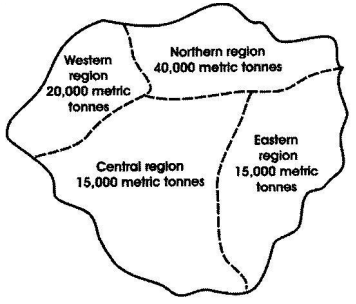1.
Which of the following latitudes almost divides the African continent into two equal halves?
Tropic of Cancer
Tropic of Capricorn
Equator
Prime Meridian
2.
Which of the following is important in the manufacture of cutting tools?
Tin
Iron
Silver
Lead
3.
Children under the age of five years should be immunized against all the following diseases except
Polio
Tetanus
Cholera
Diphtheria
4.
The League of Nations was formed immediately after the
Middle East War
Gulf War
First World War
Second World War
5.
The main means of transportation in The Gambia is
road
rail
air
water
6.
The Asantes were led in a war against the British in 1900 by
Osei Tutu
Osei Kodwo
Kwasi Obodum
Nana Afriyie
7.
If the time in Accra on longitude zero degree is 2:30 pm the time in Cairo on longitude 30° E will be
4:30 pm
5:30 pm
6:30 pm
7:30 pm
8.
Which of the following is not a cereal crop?
Rice
Maize
Wheat
Millet
9.
Malnutrition among children often results in
Polio
Tetanus
Measles
Kwashiorkor
10.
Aluminium is obtained from
copper ore
tin ore
iron ore
gold
11.
Which organ of the Organization of African Unity (OAU) has the highest authority?
General Secretariat
The Council of Ministers
The Assembly of Heads of States and Governments
The Commission of Peace
12.
The capital of the old Ghana Empire was
Walata
Timbuktu
Jeriba
Diara
13.
The United Nations Day is celebrated every year on
24th October
24th November
24th December
24th January
24th February
14.
Which of the following areas in Ghana is most likely to experience relief rainfall?
Lowlands
Accra Plains
Northern Lowlands
Kwahu Scarp
15.
The British Togoland joined Ghana in the year
1948
1951
1956
1957
16.
Who was the Head of State of Ghana between 1954 and 1960?
Dr Kwame Nkrumah
Dr J. B. Danquah
The Queen of Britain
Dr K. A. Busia
17.
The most important commercial crop in Ghana is
sheanut
cocoa
cola nut
coffee
18.
The Bond of 1844 was a peace agreement signed between the people of Southern Ghana and
Captain George Maclean
Sir Alan Burns
Sir Gordon Guggisberg
Sir Charles McCarthy
19.
The country which shares a common border with Ghana in the North is
Cote d'Ivoire
Togo
Nigeria
Burkina Faso
20.
The largest vegetation type in Ghana is
Sahel savanna
Guinea savannah
Mangrove forest
Coastal thicket
21.
The coastal wind which blows from land towards the sea at night is called
Harmattan
Sea Breeze
South-West Monsoon
Land Breeze
22.
The meeting point of two rivers is called the
mouth
drainage
source
terminus
23.
Which of the following is a bad effect of heavy rainfall?
Provision of potable water
Provision of water for irrigation
Increasing the volume of streams
Causing erosion of soil
24.
The Poll Tax Ordinance failed because the
chiefs did not agree with the British to levy tax
people had no money to pay the tax
British used the money to support the Asantes against the Fantes
tax was too high for the people
25.
Which of the following is not an element of the weather?
Rain
Wind
Thermometer
Sunshine
26.
26. Which of the following is a secondary economic activity?
Forestry
Fishing
Quarrying
Ranching
27.
Which of the following types of timber is not found in the tropical forest of West Africa?
Mahogany
Spruce
Wawa
Odum
28.
The most important mineral product of the Niger Delta is
Petroleum
Tin
Coal
Bauxite
29.
Fish can be preserved in the following ways except by
smoking
salting
drying
cooking
30.
Which of the following is not a main food crop cultivated in Ghana?
Maize
Plantain
Cocoyam
Wheat
31.
The last Governor-General of Ghana was
Sir Charles Noble Arden-Clarke
Sir Gordon Guggisberg
Captain George Maclean
Sir Garnet Wolsley
32.
The first British governor to draw up a development plan for the Gold Coast was
Sir Alan Burns
Commander Hill
Lord Listowel
Sir Gordon Guggisberg
33.
Limestone changes under great heat and pressure to become
quartzite
slate
gneiss
graphite
34.
Who was the first Ghanaian chief justice?
Sir Arku Korsah
Dr. JB Danquah
Justice Apaloo
R.A.C Crabbe
35.
The Headquarters of the United Nations Organization is in
Geneva
Washington
New York
Amsterdam
36.
The body that is working to prevent another world war is the
United Nations Organization (UNO)
League of Nations
Non-Aligned Movement (NAM)
Organization of African Unity (OAU)
37.
Which of the following cannot be considered as an environmental hazard?
Desertification
Bush fires
Afforestation
Soil erosion
38.
The Economic Community of West African States (ECOWAS) was formed in
1974
1975
1976
1977
39.
At the United Nations Organization, veto power is used by the
International Court of Justice
Food and Agricultural Organization
Permanent Members of the Security Council
General Assembly
40.
Cotton is the main raw material used in making
paper
shoes
cigarettes
furniture
Use the map below to answer the following questions

(a)
Draw the bar graph to represent the consumption of fertilizer by the four regions of Chero.
(b)
Calculate the total volume of fertilizers used in Chero as shown on the map.
(c)
Which two regions used the least amount of fertilizer in Chero?
(a)
Name the three (3) types of rainfall.
(b)
With the aid of a diagram, describe how any one type of rainfall is formed.
(a)
Mention four types of agricultural practices in Ghana.
(b)
Give two advantages and two disadvantages each of any two of the types of agricultural practices mentioned in (a) above.
Explain the importance of a named festival of one tribe in Ghana.
(a)
What are the four major problems related to cattle rearing in Africa.
(b)
Suggest solutions to any two of these problems.
(a)
State five aims of the Organization of African Unity (O.A.U).
(b)
Mention five achievements of the Organization of African Unity (O.A.U).